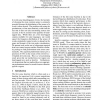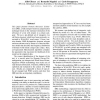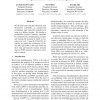126 search results - page 13 / 26 » Unsupervised word sense disambiguation using WordNet relativ... |
ACL
2004
13 years 8 months ago
2004
In word sense disambiguation (WSD), the heuristic of choosing the most common sense is extremely powerful because the distribution of the senses of a word is often skewed. The pro...
EMNLP
2004
13 years 8 months ago
2004
This paper presents Domain Relevance Estimation (DRE), a fully unsupervised text categorization technique based on the statistical estimation of the relevance of a text with respe...
PAMI
2010
13 years 5 months ago
2010
— Word sense disambiguation (WSD), the task of identifying the intended meanings (senses) of words in context, has been a long-standing research objective for natural language pr...
EMNLP
2007
13 years 8 months ago
2007
We develop latent Dirichlet allocation with WORDNET (LDAWN), an unsupervised probabilistic topic model that includes word sense as a hidden variable. We develop a probabilistic po...
AAAI
1998
13 years 8 months ago
1998
We present a corpus{based approach to word{sense disambiguation that only requires information that can be automatically extracted from untagged text. We use unsupervised techniqu...



